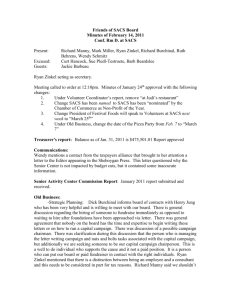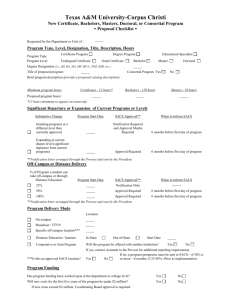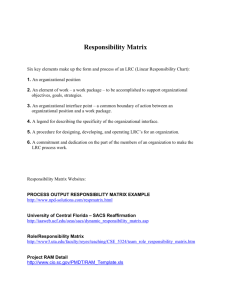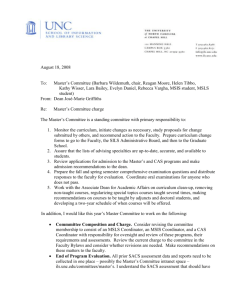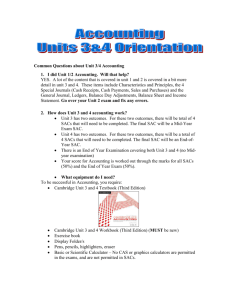Tulare County Office of Education
advertisement
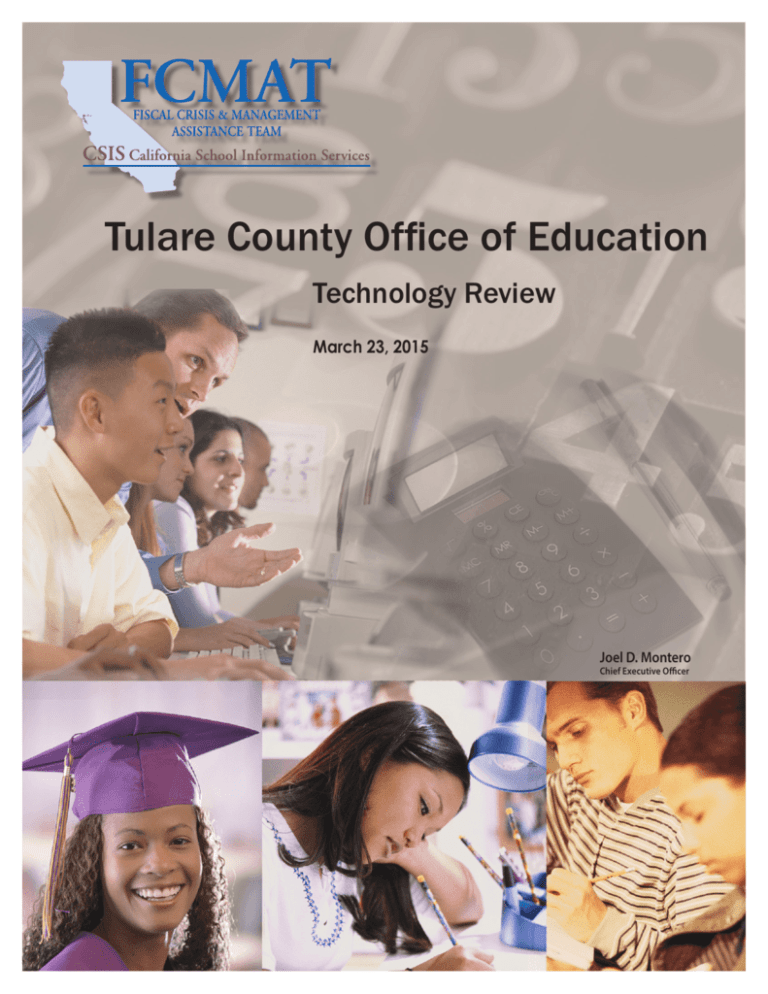
Tulare County Office of Education Technology Review March 23, 2015 Joel D. Montero Chief Executive Officer Fiscal Crisis & Management Assistance Team March 23, 2015 Jim Vidak, Superintendent of Schools Tulare County Office of Education 2637 W. Burrel Ave. Visalia, CA 93278-5091 Dear Superintendent Vidak: In August 2014, the Tulare County Office of Education and the Fiscal Crisis and Management Assistance Team (FCMAT) entered into an agreement to provide a review of the district’s technology programs and services. Specifically, the agreement stated that FCMAT would perform the following: 1. Conduct a comprehensive analysis of the county’s integrated financial system including hardware, software, and project management. 2. Review the ability and timeliness of the software development group to develop an effective position control system. 3. Analyze methods used to determine priorities for software development. 4. Review the staffing of the software development group and determine if it is adequate to meet the changing requirements of mandated state reporting for finance and payroll. 5. Review the job descriptions of the software development group to ensure that they reflect industry-standard software development requirements. 6. Review the duties that members of the software development group perform and compare those to the duties in the job descriptions. 7. Make staffing and professional development recommendations based on the amount of support needed to meet county and state requirements. 8. Review the Information Systems department’s non-personnel-related expenditures for the past two fiscal years and make recommendations for cost reductions and/or alternative expenditures. This final report contains the study team’s findings and recommendations in the above areas of review. FCMAT appreciates the opportunity to serve the Tulare County Office of Education, and extends thanks to all the staff for their assistance during fieldwork. Sincerely, Joel D. Montero Chief Executive Officer Fiscal Crisis & Management Assistance Team TA B L E O F C O N T E N T S Table of Contents Foreword............................................................................................................iii Introduction...................................................................................................... 1 Background..................................................................................................................1 Study and Report Guidelines.................................................................................2 Study Team...................................................................................................................2 Executive Summary............................................................................... 3 Findings and Recommendations...................................................... 5 Financial System.............................................................................................. 5 Development History...............................................................................................5 Development and Implementation.....................................................................5 Position Control Application Development......................................................7 Mandated Requirement Changes and Other SACS Financial System Development...............................................................................................................9 Support and Development Tools.........................................................................9 Help Desk....................................................................................................................10 Organizational Structure and Job Descriptions.............................................11 Staffing and Continuity..........................................................................................12 Team Planning and Communication.................................................................13 Internal Development versus Enterprise Resource Planning Systems...14 Non-Personnel-Related Technology Expenditures........................... 15 Appendices.............................................................................................17 Tulare County Office of Education i ii Fiscal Crisis & Management Assistance Team A B O U T F C M AT About FCMAT FCMAT’s primary mission is to assist California’s local K-14 educational agencies to identify, prevent, and resolve financial and data management challenges. FCMAT provides fiscal and data management assistance, professional development training, product development and other related school business and data services. FCMAT’s fiscal and management assistance services are used not just to help avert fiscal crisis, but to promote sound financial practices and efficient operations. FCMAT’s data management services are used to help local educational agencies (LEAs) meet state reporting responsibilities, improve data quality, and share information. FCMAT may be requested to provide fiscal crisis or management assistance by a school district, charter school, community college, county office of education, the state Superintendent of Public Instruction, or the Legislature. When a request or assignment is received, FCMAT assembles a study team that works closely with the local education agency to define the scope of work, conduct on-site fieldwork and provide a written report with findings and recommendations to help resolve issues, overcome challenges and plan for the future. Studies by Fiscal Year 90 80 Number of Studies 70 60 50 40 30 20 10 0 92/93 93/94 94/95 95/96 96/97 97/98 98/99 99/00 00/01 01/02 02/03 03/04 04/05 05/06 06/07 07/08 08/09 09/10 10/11 11/12 FCMAT also develops and provides numerous publications, software tools, workshops and professional development opportunities to help local educational agencies operate more effectively and fulfill their fiscal oversight and data management responsibilities. The California School Information Services (CSIS) arm of FCMAT assists the California Department of Education with the implementation of the California Longitudinal Pupil Achievement Data System (CALPADS) and also maintains DataGate, the FCMAT/CSIS software LEAs use for CSIS services. FCMAT was created by Assembly Bill 1200 in 1992 to assist LEAs to meet and sustain their financial obligations. Assembly Bill 107 in 1997 charged FCMAT with responsibility for CSIS and its statewide data management work. Assembly Bill 1115 in 1999 codified CSIS’ mission. AB 1200 is also a statewide plan for county offices of education and school districts to work together locally to improve fiscal procedures and accountability standards. Assembly Bill 2756 (2004) provides specific responsibilities to FCMAT with regard to districts that have received emergency state loans. In January 2006, SB 430 (charter schools) and AB 1366 (community colleges) became law and expanded FCMAT’s services to those types of LEAs. Tulare County Office of Education iii iv A B O U T F C M AT Since 1992, FCMAT has been engaged to perform more than 1,000 reviews for LEAs, including school districts, county offices of education, charter schools and community colleges. The Kern County Superintendent of Schools is the administrative agent for FCMAT. The team is led by Joel D. Montero, Chief Executive Officer, with funding derived through appropriations in the state budget and a modest fee schedule for charges to requesting agencies. Fiscal Crisis & Management Assistance Team INTRODUCTION Introduction Background Tulare County is in central California, south of Fresno, and includes portions of the San Joaquin Valley and the Sierra Nevada. The county spans 4,824 square miles, including Sequoia National Park and part of Kings Canyon National Park. As of the 2010 census, the population was 442,179, with 67.7% of the population residing in eight incorporated cities. Over 25% of the county’s population resides in Visalia, the county seat. The economy in Tulare County is primarily agriculture, with dairy, oranges, grapes and cattle-related commodities driving local economies. The median household income in Tulare County is $42,708. The Tulare County Office of Education provides education and business services to 44 school districts. In August 2014 the Tulare County Office of Education requested that FCMAT assist the county office by reviewing its technology programs and services. The study agreement specifies that FCMAT will perform the following. 1. Conduct a comprehensive analysis of the county’s integrated financial system including hardware, software, and project management. 2. Review the ability and timeliness of the software development group to develop an effective position control system. 3. Analyze methods used to determine priorities for software development. 4. Review the staffing of the software development group and determine if it is adequate to meet the changing requirements of mandated state reporting for finance and payroll. 5. Review the job descriptions of the software development group to ensure that they reflect industry-standard software development requirements. 6. Review the duties that members of the software development group perform and compare those to the duties in the job descriptions. 7. Make staffing and professional development recommendations based on the amount of support needed to meet county and state requirements. 8. Review the Information Systems department’s non-personnel-related expenditures for the past two fiscal years and make recommendations for cost reductions and/or alternative expenditures. Tulare County Office of Education 1 2 INTRODUCTION Study and Report Guidelines FCMAT visited the county office on October 22-23, 2014 to conduct interviews, collect data and review documents from the Tulare County Office of Education. The scope of work was limited to exclude interviewing, collecting data and reviewing documents from supported districts. This report is the result of those activities and is divided into the following sections: • Executive Summary • Financial System • Non-Personnel-Related Technology Expenditures • Appendices In writing its reports, FCMAT uses the Associated Press Stylebook, a comprehensive guide to usage and accepted style that emphasizes conciseness and clarity. In addition, this guide emphasizes plain language, discourages the use of jargon and capitalizes relatively few terms. Study Team The study team was composed of the following members: Andrea AlvaradoDane Lancaster* FCMAT Management Analyst Senior Director, Information Technology Bakersfield, CA Marin County Office of Education San Rafael, CA Bruce Storer* Coordinator I, Information Systems Laura Haywood Kern County Superintendent of Schools FCMAT Technical Writer Bakersfield, CABakersfield, CA *As members of this study team, these consultants were not representing their respective employers but were working solely as independent contractors for FCMAT. Each team member reviewed the draft report to confirm accuracy and achieve consensus on the final recommendations. Fiscal Crisis & Management Assistance Team EXECUTIVE SUMMARY Executive Summary The Tulare County Office of Education has a long history of developing custom financial system software, beginning in 1980. In 1995 the county office created a consortium with four other agencies to develop a financial system called the Standardized Account Code System (SACS financial system). Since the disbanding of the consortium in approximately 1999, the SACS financial system is developed and maintained by in-house Information Systems staff. The support and development process is decentralized among staff, lacking consistent programming standards, project management, and support tracking. This has led to significantly delayed high profile project rollouts. Because communication and coordination are lacking, management does not have the information necessary to determine the shortcomings of the process and determine if additional programming resources are necessary. Further, it has led to an informal support structure, resulting in the inefficient use of staff resources. Communicating programming standards, implementing project management software, and implementing help desk support software would allow the department to more consistently reach target timeline goals. The organizational structure is appropriate for the duties of the department. The development group has demonstrated the ability to respond to state and federal mandates in a timely manner. However, the delay in developing an integrated position control system suggests that the software development group does not have the capacity to respond to new state and federal mandates while continuing work on high priority local projects and support end users in day-to-day operations. A vacant programmer analyst position could be staffed and reassigned to assist in additional software development projects for the SACS financial system. After implementation of project management software and help desk support software, the resulting reports should be used to determine if another programmer analyst position is necessary. The Information Systems department does not meet regularly, nor does it hold regular meetings with departments to discuss outstanding projects. With the new intake communication pathways created by the project management and help desk systems, weekly Information Systems management staff meetings, monthly Information Systems staff meetings and quarterly interdepartmental meetings will help determine and communicate priorities, outstanding issues, and other SACS financial system information. The SACS financial system is developed primarily for use by the county office and provided free of cost to in-county districts, limiting funding for future development and constraining development to county office needs. Many enterprise resource planning (ERP) systems are designed to function for a broader base of clients and may be more functional for the variety of school districts represented in Tulare County. The county office should consider re-evaluating the funding structure for the SACS financial system or evaluate ERP systems for potential conversion. Tulare County Office of Education 3 4 Fiscal Crisis & Management Assistance Team FINANCIAL SYSTEM Findings and Recommendations Financial System Development History State statutes passed in 1993 and 1995 called for development of a statewide model accounting and budget structure across all school district and county school agencies. Subsequently, the Standardized Account Code Structure (SACS) was developed, a defined account code string of seven fields and universally defined chart of accounts that allowed the state of California to report properly to the federal government by unifying many individual school agency accounting structures and allowing timely compilation of information on a statewide basis. The 1996 Budget Act appropriated a total of $6 million to four consortia to implement SACS as phase 1. The intent was for phase 2 participants to benefit from phase 1’s efforts and experience The Tulare County Office of Education has a long history of developing custom financial system software, beginning in 1980. In 1995 the county office created a consortium with four other agencies: the Kings County, Fresno County, Monterey County and Imperial County offices of education, to develop a financial system that complied with the new requirement. The financial software created by this consortium was called the Standardized Account Code System (SACS financial system). After the initial design, development and implementation of the SACS financial system, the consortium continued to modify the software, with each member agency taking responsibility for development of a different section of the software, for example human resources, budget or position control. Over time, the consortium found that it was hard to develop some sections of the system to meet the needs of all its members, and the consortium disbanded in approximately 1999. Each agency continued independent development of the software beyond that version. Some member agencies have since transitioned away from developing a local custom system. The SACS financial system is the primary financial system used by the Tulare county office and 43 in-county districts. One in-county district, Visalia Unified School District, is not on the SACS financial system. Development and Implementation Since the disbanding of the consortium, the SACS financial system is developed and maintained by in-house Information Systems staff. Lack of a common software development methodology combined with the lack of project management has resulted in staff developing application changes and enhancements using their own preferred methods and tools. The application development life cycle is divided into five general phases: planning, analysis, design, implementation and maintenance (see figure 1). Software development methodology further divides the development work into distinct phases. For example, the rapid application development (RAD) methodology starts with requirements planning and progresses with iterative prototype modeling to refine the results before moving to cutover, or the point the application is placed in production (see figure 2). Multiple software development methodologies have developed over time. Some common examples include waterfall, prototyping, iterative and incremental development, spiral development, rapid application development, extreme programming, and agile methodology. Each methodology has its own strengths and weaknesses, and an Tulare County Office of Education 5 6 FINANCIAL SYSTEM organization’s selection of a methodology is individual to the culture, resources available and project scope. Project management is the process of planning, organizing, staffing, directing and controlling the production of a system. The function of project management is to achieve the project’s goals while adhering to constraints in scope, time, quality and budget. In software development, it is a key component to efficiently directing resources and administering procedures and protocols. There are many software tools available for project management. A good project management tool will be easy to use, integrate with core applications like email, offer good vendor and community support, and allow for collaboration and scaling. Some examples of project management software include Trello, Producteev, GanttProject and Microsoft Project. Operating without a defined software development methodology and project management in place has resulted in a lack of continuity in the development process and programming language, delayed project completions and increased end user frustration. Further, the lack of project control in the department has permitted the growth of an informal operational culture resulting in the inefficient use of staff resources. The SACS financial system was initially developed using the Microsoft Visual Basic 6.0 (VB6) programming language. Ongoing fixes and enhancements are primarily completed in VB6. However, limited recent modifications and additions to the software have been developed in the Microsoft Visual Basic .NET (VB.NET) programming language. VB.NET was developed by Microsoft as the replacement update for VB6; however, VB6 continues to exist widely as legacy code, with new development generated in VB.NET as the industry standard. In continued development of the SACS financial system, VB6 is used due to staff programmers’ perceived time constraints and the familiarity with it. The lack of common methodology and programming language can lead to duplication of efforts and complex, potentially error-prone programming. Additionally, the extra complexity makes it more difficult to debug and integrate into the core SACS financial system. Future maintenance of software engineered without strict standards can be problematic and time consuming because of unnecessary complications and coding evaluation. Following coding standards makes code easier to modify and maintain, whether the developers remain on the same projects over time or move on to other projects. A project management approach, with end user requests filtering through management and assigned to staff would alleviate the urgency felt by staff and result in a more consistent product. Additionally, it would provide management with a complete understanding of outstanding and total support requests and current workloads. Using project management tools would help IS managers plan and assign project tasks, set milestones and timelines, measure project progress, plan for contingencies, and hold staff accountable for task assignments. This information would further allow management to assess progress, reassess and communicate priorities as new items are added, and keep customers informed of the status of their projects. Effective project management would lead to more efficient use of staff and resources. Recommendations The county office should: 1. Select and implement a daily use, general SACS financial system development methodology. Review and consider alternative methodologies for large projects. 2. Select and implement project management software. Require all SACS financial system development staff to use the software. Fiscal Crisis & Management Assistance Team FINANCIAL SYSTEM 3. Standardize on a single programming language, VB.NET, for maintenance and future development of the SACS financial system. 4. Form a migration team with established priorities, goals, measurable results and a timeline to migrate the VB6 application code to VB.NET. 5. Provide clear and timely communication to SACS financial system customers regarding system modifications and implementation plans. Position Control Application Development The original SACS financial system software did not contain a position control application. The SACS financial system development staff have been working on developing a position control application for years. Midway through, the project changed key staff, which resulted in a re-evaluation of the planning, analysis and design phases. Staff in the human resources, internal and external business service departments have adapted to the lack of a position control system by utilizing employee-based spreadsheets to track, monitor, and fill positions and personnel assignments and to generate budgets. However, an employee-based system is not ideal for budgeting or analyzing employment levels because of the inability to identify authorized open positions, shared positions and other staffing anomalies. In contrast, a position control system starts with a numbered, authorized position with a defined budget, then personnel are assigned to the position. Often, position control applications include tracking of work calendars and provide position vacancy history. Ideally, the position control system is integrated with a financial system for easy budget and payroll integration. A component of good internal control, the position control process protects against position overassignment, underbudgeting, and payroll overpayment. Small organizations may be able to monitor, manage and project staff expenses using simpler tools, like spreadsheets. However, large organizations like the Tulare County Office of Education need more sophisticated systems to track, report, manage and sufficiently budget for employee salaries and benefits. Staffing levels fluctuate naturally throughout the year as employees are hired, terminated or shift between positions. An employee-based system, like spreadsheets, makes it cumbersome to track allocated funding and authorized positions. The human resources department must be able to identify reduced staffing levels to fill vacant positions in a timely manner. With total staffing costs averaging over 75% of all expenditures in most California school districts, department/site managers must have position information to manage their budgets. A single position that is overfilled or underfunded will negatively impact the budget. Knowing the correct number of authorized positions and cost of assigned employees helps departments manage their resources to provide services and meet demands and deadlines. A beta position control application demonstration with limited test data was performed during fieldwork. The SACS financial system position control application appears to contain all of the data fields necessary for a well-functioning system. The programmers responsible for development were knowledgeable about required functionality, processes and position details. Some basic reports have been developed, with plans to develop more projection and core position related reporting during testing with end user input. The underlying master files appear to meet business requirements. Integration of position control with payroll is planned for future development. The system is in the beta testing phase of development. The county initially planned for a small district to enter full-time employee position data for testing. However, the district that initially agreed to test was unable to continue due to staff turnover. Testing is an important component of software development. It provides a guide to confirming that the application: Tulare County Office of Education 7 8 FINANCIAL SYSTEM • meets the requirements that guided design and development • responds correctly to all kinds of input • performs its functions within an acceptable time • is sufficiently usable • achieves the general result end-users desire. Software testing can be a time consuming task. However, it is a temporary investment in a tool that will provide long-term workflow efficiencies. Since the county office would be the largest user of the position control system, it would benefit from participation in testing. Testing the entire position list from the county office would be cumbersome. Instead, the county office’s human resource and internal business department staff could sample and use a cross-section of classified and certificated employees, starting with the simplest situations and moving toward the complex. Due to the perceived lack of progress on the SACS financial system position control application, the human resources department purchased Analytic Schools, a third-party, non-SACS financial system integrated product. Conversion from the spreadsheets to Analytic Schools was under way during fieldwork. The human resources staff is working directly with the vendor to get Analytic Schools set up. Although it may be a short-term solution in the effort to modernize human resources’ internal business processes, the lack of integrated payroll, personnel, and position control with the SACS financial system will require dual entry of data across divisions and the manual processing of personnel action forms. In interviews with staff, it appears that the setup being done for Analytic Schools would align with the information needed to set up the position control application in the SACS financial system. Periodic update meetings between human resources, internal business and the Information Systems department will improve communication regarding the position control project. Senior Information Systems department management should commit to and support the continued development of the SACS financial system position control module for at least an additional nine months. After that, a formal project evaluation should be completed to assess progress and a decision to continue development, provide more resources, or change direction should be made. Recommendations The county office should: 1. Assign two human resources staff to beta test the SACS financial system position control module using a cross-section of classified and certificated employees. 2. Hold weekly status and review meetings about position control with the director of human resources, testing staff, Information Systems director and the development team. 3. Complete a formal project evaluation to assess project progress and measure outcomes. Fiscal Crisis & Management Assistance Team FINANCIAL SYSTEM Mandated Requirement Changes and Other SACS Financial System Development While position control development has significant challenges, the Information Systems department has had other successful SACS financial system developments. These rollouts demonstrate the impact of staff’s ability to focus on assigned priority tasks. As discussed in the Development and Implementation section, implementation of project management software will help eliminate the competing priorities and specifications, creating an environment that will produce consistent successful results. Mandated requirement changes have required a lot of development work to the SACS financial system. Changes to the Public Employees’ Retirement System (PERS) and new requirements by the Affordable Care Act (ACA) have proven to be a challenge to software vendors throughout California. In-house application developers have faced similar challenges to provide software updates under short implementation timelines. Management communicated that these projects were high priority, and staff tabled other projects, including the position control application development, to complete them on time and to the business department’s satisfaction. Other completed enhancements to the SACS financial system have provided time and cost savings, and allow staff to provide better customer service to employees. For example, E-Port, an employee portal that allows employees to view their payroll deposit notices and W-2s online, was recently released. Additionally, development of direct vendor deposits streamlines the accounts payable process and reduces form costs. Support and Development Tools Adequate software and application version control tools are used to support development projects. The use of Microsoft’s Visual SourceSafe and Microsoft’s Team Foundation server source code revision management lets development teams quickly and efficiently share files among projects. Code in development is kept in an area isolated from production. However, the development team does not have a staging area for software acceptance testing. A software release process includes a location for development, acceptance testing and production code. An acceptance testing area is used to evaluate and use new functionality without worrying about affecting business operations. The process to manage software releases is more risky without a properly isolated testing environment. Maintaining a clean production area that includes only formally released and tested code prevents application errors and software defects. A best practice is to migrate applications from development to acceptance testing and finally to production. Recommendation The county office should: 1. Introduce a staging area for software acceptance testing. Routinely repopulate this environment with production data. Tulare County Office of Education 9 10 FINANCIAL SYSTEM Help Desk The county office lacks a consistent method to request support for the SACS financial system. County office end users obtain service by contacting Information Systems staff members directly in person, by phone or in email. Requests are discussed and then prioritized against other tasks by the individual Information Systems staff member. To provide excellent customer service, minor customer issues end up taking higher priority over larger projects or other outstanding needs of customers. The immediate needs of customers are addressed, but long-term goals of the department are sacrificed. The absence of a central help desk encourages constant interruption of Information Systems staff. Software development and troubleshooting is best done with long spans of uninterrupted thought and focus. Contiguous time during software development to analyze and program will result in fewer programming errors. This also provides adequate time for thorough problem solving and helps ensure that competing timelines are appropriately prioritized and met. The number of support requests open, completed or pending is unknown since there is no common method to initiate, follow-up or prioritize requests. Every development staff member accepts SACS financial system customer requests, and not all requests are conveyed to management. This lack of formal assignment may lead to two or more staff working on the same issue. Information and steps used to resolve a problem or answer a question are not logged into a central location for future reference. Access to past problems and questions improve solution response times, consistency and effectiveness of the help desk staff. A repository of how to fix a problem or frequently asked questions will allow routine support requests to be resolved without involvement of programmers. Because no method exists to initiate, assign or prioritize a request it is hard to quantify the demands on Instructional Services staff. It is difficult to follow up or keep the support requestor informed. Most importantly, there is no way to know if and when a request is resolved and can be closed. Best practice is to initiate all service requests through a help desk system, allowing management to prioritize outstanding tasks and allocate resources correctly. The information gained via the help desk can be used to determine end user training needs, support staffing change requests, and provide management tools to monitor completed and outstanding requests. Recommendations The county office should: 1. Evaluate, purchase and use a help desk software application that includes fields for setting priority, staff assignment, tracking, solution tracking, and reporting and knowledge base features. 2. Designate the business service liaison as the primary contact for SACS financial system support requests (email, telephone). Have this person escalate tickets to Information Systems management as necessary to set priority, add to the project management system and assign development staff. 3. Require solution information to be entered into the system to build a knowledge base. Fiscal Crisis & Management Assistance Team FINANCIAL SYSTEM 4. Establish a help desk telephone number and email address, like helpdesk@ tcoe.org. Except in emergencies, require all support requests to be submitted via the help desk to accurately manage, prioritize, and quantify support requests. Have the business services liaison monitor and enter into the system the support requests received by phone. 5. Add frequently asked questions, status of major projects, the help desk email address, future implementation schedules and completed project information to the tcoe.org Information Systems web page. Organizational Structure and Job Descriptions The Information Systems department is led by the director of information systems. The department is organized into a development team and a support team. The development group is composed of two applications manager positions and six programmer analysts, three of which have primary duties other than SACS financial system development. The support team is comprised of four positions, with only the business services liaison position primarily related to SACS financial system support. Additionally, two positions share development and support duties: a web developer and a system programmer analyst. The department organization is appropriate for the services provided. Job descriptions were requested for all positions in the Information Systems department. Computer programmer analyst and senior programmer analyst job descriptions were provided in lieu of a programmer analyst job description. Interviews indicated that the department is undergoing a transition to develop new talent and provide continuity among its programmer analyst staff. The following job descriptions were not provided: system programmer analyst, web developer, and business services liaison. The system programmer analyst and business services liaison positions are relevant to the development and support of the SACS financial system software. Interviews indicated the positions were developed in response to need and did not have an official job description. All other job descriptions were provided for review. The oldest job description provided, the application manager description, was developed in 1999 and the newest, senior programmer analyst, was developed in 2013. Older job descriptions, such Tulare County Office of Education 11 12 FINANCIAL SYSTEM as the application manager, still reference the outdated VB6 standard. Newer job descriptions, such as the senior programmer analyst, contain an updated reference to VB.NET. Outdated programming references in job descriptions may limit the county’s ability to attract new employees with the appropriate skills. Recommendations The county office should: 1. Work with human resources and staff to develop job descriptions for the system programmer analyst, web developer, and business services liaison. 2. Update references in job descriptions to require knowledge of and skills in modern programming languages such as VB.NET. Include language that requires experience migrating legacy VB6 to other modern code frameworks. Staffing and Continuity The SACS financial system development staff is divided into two teams. One application manager oversees the development of payroll and personnel applications and supervises two programmer analysts. The other manager oversees the development of budget, financial and accounts payable applications and supervises one programmer analyst. Both application managers report they spend 50% or more of their time programming so they can meet software project timelines. The application manager job description states that the position’s primary function is designing, developing and implementing financial software. Project management is key to the timely and successful delivery of software applications that meet the needs of the organization. If the application manager does not have the time to interact with end users and focus on guiding each project to completion, the objectives driving the development of the application may be obscured. There is then the risk that the end product does meet the application requirements as designed. Because they must devote most of their time to programming, the application managers are not able to effectively carry out their primary duties. The development staff has concentrated on developing software to comply with new state and federal mandates, developing a position control system, and supporting other miscellaneous end user requests. While under development, the retirement reporting and ACA modules consumed the resources of the team dedicated to payroll and personnel development. To comply with the mandates the applications group allocated most of its available resources to the ACA, PERS, and STRS projects. Work stopped on the high priority position control project. The development group has demonstrated the ability to respond to state and federal mandates in a timely manner. However, the delay in a much needed integrated position control system suggests that the software development group does not have the capacity to respond to new state and federal mandates and at the same time continue work on high priority local projects. The director of Information Systems has intent to retire within the next five years. Both applications managers are longtime employees of 25 years or more and are approaching retirement age. The county office provides essential financial data management services to all but one of the public school districts in Tulare County. A best practice in the operation of essential services is to ensure that redundancy and system elasticity is built into the staffing levels of the software development team. This staffing should be sufficient to absorb demand caused by future staff transitions or a surge in the number and complexity of projects assigned to the team. The amount Fiscal Crisis & Management Assistance Team FINANCIAL SYSTEM of programming done by application managers should be minimized to achieve efficiencies in project management. In some software development situations, increasing staff may not help the development process. Many tasks cannot or should not be divided; thus, simply adding staff doesn’t equate to a better product or speedier timeline. However, in this case there appears to be enough ongoing high priority development in addition to everyday development, which would warrant the addition of a programmer analyst. The Information Systems department has a vacant programmer analyst position that could be staffed and used for further SACS financial system development, thus relieving the application managers of some programming duties to focus more on product development management. Recommendations The county office should: 1. Fill the vacant programmer analyst position to take on the programming duties currently performed by the application managers. 2. After project management and help desk tools are implemented, use the resulting information to determine if further new programmer analyst positions are necessary. 3. Direct application managers to begin to reduce their amount of time programming and increase their time in product development and project management. 4. Develop a 3-5 year staffing plan that takes into consideration potential retirements in management positions. Team Planning and Communication The Information Systems department structure outlined in the organization chart is hierarchical. However, in practice, the software applications and support groups operate independently. Staff are tasked with projects by other departments in the organization without management’s knowledge. Status on active and planned projects is communicated informally by application managers; a list of current and planned projects is not maintained. The department team does not meet regularly to review project priorities. The department has not met for at least two years. The Tulare County Office of Education provides vital financial management services for itself and its 44 client school districts. The county office is responsible for the system that processes annual revenues and expenditures totaling more than $620 million. Therefore it is incumbent upon the county office to utilize effective industry standard practices and procedures to ensure the integrity and functionality of its services. Greater management involvement in the development and support processes would help ensure that priorities are based on the organization’s larger goals. Weekly management meetings to review open customer requests would allow management to adjust priorities and resources as needed. Monthly team meetings would allow staff to discuss challenges, current priorities, and other department business. Additionally, quarterly meetings with other departments would allow management to communicate the status of projects and development priorities. Tulare County Office of Education 13 14 FINANCIAL SYSTEM Recommendations The county office should: 1. Meet weekly with application managers to review open customer requests and adjust priorities for open and pending requests. 2. Hold monthly department staff meetings with required attendance by all members of the Information Systems department. Have the director develop meeting agendas in collaboration with the application managers. 3. Schedule quarterly meetings with managers in human resources, internal and external business to report on priority projects and discuss plans for addressing new mandates. Internal Development versus Enterprise Resource Planning Systems There are several benefits to having the SACS financial system locally developed. For example, the county office can set priorities and custom design processes to fit local environments. However, the management and support involved in maintaining a financial system that is increasingly developing toward becoming an enterprise resource planning (ERP) system is significant. Planning and developing the SACS financial system consumes most resources in the Information Systems department and additional resources in the business and human resources departments. Further, the SACS financial system is developed primarily for use by the county office and provided free of cost to in-county districts, limiting funding for future development and constraining development primarily to county office needs. An ERP system is business process management software that allows an agency to use a suite of integrated applications to manage business functions, reduce redundancy, and collect and interpret data from many business activities. Many ERP systems are available on the market that include applications and features that integrate more business activities than are available in the SACS financial system. These systems, like QSS/OASIS, PeopleSoft or Bi-Tech, are designed to function for a broader base of clients and may be more functional for the variety of school districts represented in Tulare County. ERP systems designed to function in California’s K-12 education environment continually update their software for new laws, regulations, trends and changes in technology to stay relevant in the marketplace. Additionally, some ERP vendors offer custom programming options and user communities to help fund trainings and projects that benefit the community. Based on industry standards, the county office should consider issuing a request for proposal (RFP) to evaluate ERP systems and determine if converting would be more cost effective than continuing development on the SACS financial system. Recommendations The county office should: 1. Review the practice on offering the SACS financial system free of cost to districts and consider a progressive rate structure. 2. Issue a request for proposal (RFP) for ERP system vendors to submit conversion and support cost proposals, then perform a cost/benefit analysis on continuing development of the SACS financial system versus transitioning to an ERP system. Develop a committee of county and district users of the SACS financial system to participate in the evaluation process. Fiscal Crisis & Management Assistance Team N O N - P E R S O N N E L - R E L AT E D T E C H N O L O GY E X P E N D I T U R E S Non-Personnel-Related Technology Expenditures As a final component of the financial system development study, FCMAT was requested to review the department’s non-personnel-related expenditures over the past two years and make recommendations for cost reductions and/or alternative expenditures if found. After consideration of the expenditure list, the team has no additional recommendations. Tulare County Office of Education 15 16 Fiscal Crisis & Management Assistance Team A P P E NDDRI C AE FS T Appendices Appendix A Study Agreement Tulare County Office of Education 17 18 DR A PP A EF N TDICES Fiscal Crisis & Management Assistance Team A P P E NDDRI C AE FS T Tulare County Office of Education 19 20 DR A PP A EF N TDICES Fiscal Crisis & Management Assistance Team A P P E NDDRI C AE FS T Tulare County Office of Education 21 22 DR A PP A EF N TDICES Fiscal Crisis & Management Assistance Team

